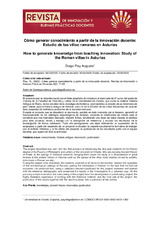Mostrar el registro sencillo del ítem
Cómo generar conocimiento a partir de la innovación docente: Estudio de las villae romanas en Asturias
| dc.contributor.author | Piay Augusto, Diego | |
| dc.date.accessioned | 2020-10-30T08:16:07Z | |
| dc.date.available | 2020-10-30T08:16:07Z | |
| dc.date.issued | 2020 | |
| dc.identifier.issn | 2531-1336 | |
| dc.identifier.uri | http://hdl.handle.net/10396/20673 | |
| dc.description.abstract | El proyecto que se describe nació con el firme propósito de introducir al alumnado de 2º curso del grado de Historia de la Facultad de Filosofía y Letras de la Universidad de Oviedo, que cursa la materia Historia Antigua de Roma, en los resortes de la investigación histórica, acercándolos al estudio de un fenómeno de gran interés para la historia antigua de Asturias como lo es la difusión de las villae (haciendas de carácter rural propiedad de individuos pudientes de la sociedad romana). Durante el proyecto que se describirá, el alumnado, asistido en todo momento por el docente, aprendió el funcionamiento de los catálogos arqueológicos de Asturias, vaciando la información de interés para el cometido que nos habíamos marcado; elaboró fichas, empleando una base de datos creada ex profeso para este proyecto; revisó y trabajó con la bibliografía de referencia; y expuso los resultados de la investigación de forma coherente. Todo ello persiguiendo una triple motivación: la superación de la asignatura a partir del desarrollo de un proyecto motivador; la experiencia altamente formativa de trabajar con el método histórico; y el fin último del proyecto: la publicación de los resultados junto con el equipo docente, que supervisó toda la actividad. | es_ES |
| dc.description.abstract | The project described was born with the firm purpose of introducing the 2nd year students of the History degree of the Faculty of Philosophy and Letters of the University of Oviedo, who are studying Ancient History of Rome, in the springs of historical research, bringing them closer the study of a phenomenon of great interest to the ancient history of Asturias such as the spread of the villae (rural estates owned by wealthy individuals in Roman society). During the project to be described, the students, assisted at all times by the teacher, learned the operation of the archaeological catalogs of Asturias, getting the information of interest for the task that we had set ourselves; He produced files, using a database created specifically for this project; reviewed and worked with the reference bibliography; and presented the results of the investigation in a coherent way. All this pursuing a triple motivation: the overcoming of the subject from the development of a motivating project; the highly formative experience of working with the historical method; and the final aim of the project: the publication of the results together with the teaching team, who supervised all the activity. | es_ES |
| dc.format.mimetype | application/pdf | es_ES |
| dc.language.iso | spa | es_ES |
| dc.publisher | UCOPress | es_ES |
| dc.rights | https://creativecommons.org/licenses/by-nc-nd/4.0/ | es_ES |
| dc.source | Revista de innovación y buenas prácticas docentes 9(2), 71-81 (2020) | es_ES |
| dc.subject | Conocimiento | es_ES |
| dc.subject | Historia antigua | es_ES |
| dc.subject | Innovación | es_ES |
| dc.subject | Publicación | es_ES |
| dc.subject | Knowledge | es_ES |
| dc.subject | Ancient history | es_ES |
| dc.subject | Innovation | es_ES |
| dc.subject | Publication | es_ES |
| dc.title | Cómo generar conocimiento a partir de la innovación docente: Estudio de las villae romanas en Asturias | es_ES |
| dc.title.alternative | How to generate knowledge from teaching innovation: Study of the Roman villae in Asturias | es_ES |
| dc.type | info:eu-repo/semantics/article | es_ES |
| dc.relation.publisherversion | http://www.uco.es/ucopress/ojs/index.php/ripadoc/index | es_ES |
| dc.rights.accessRights | info:eu-repo/semantics/openAccess | es_ES |

